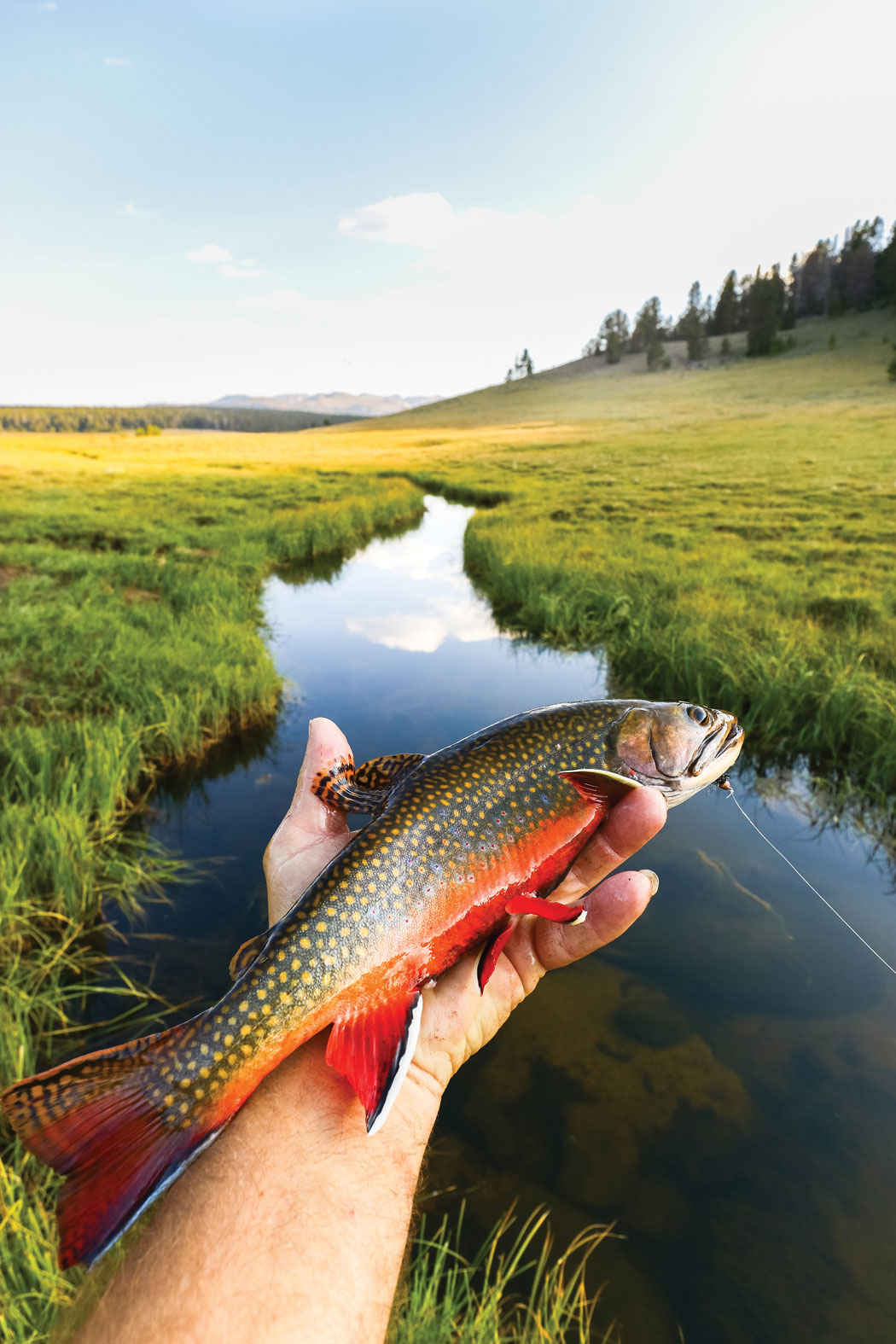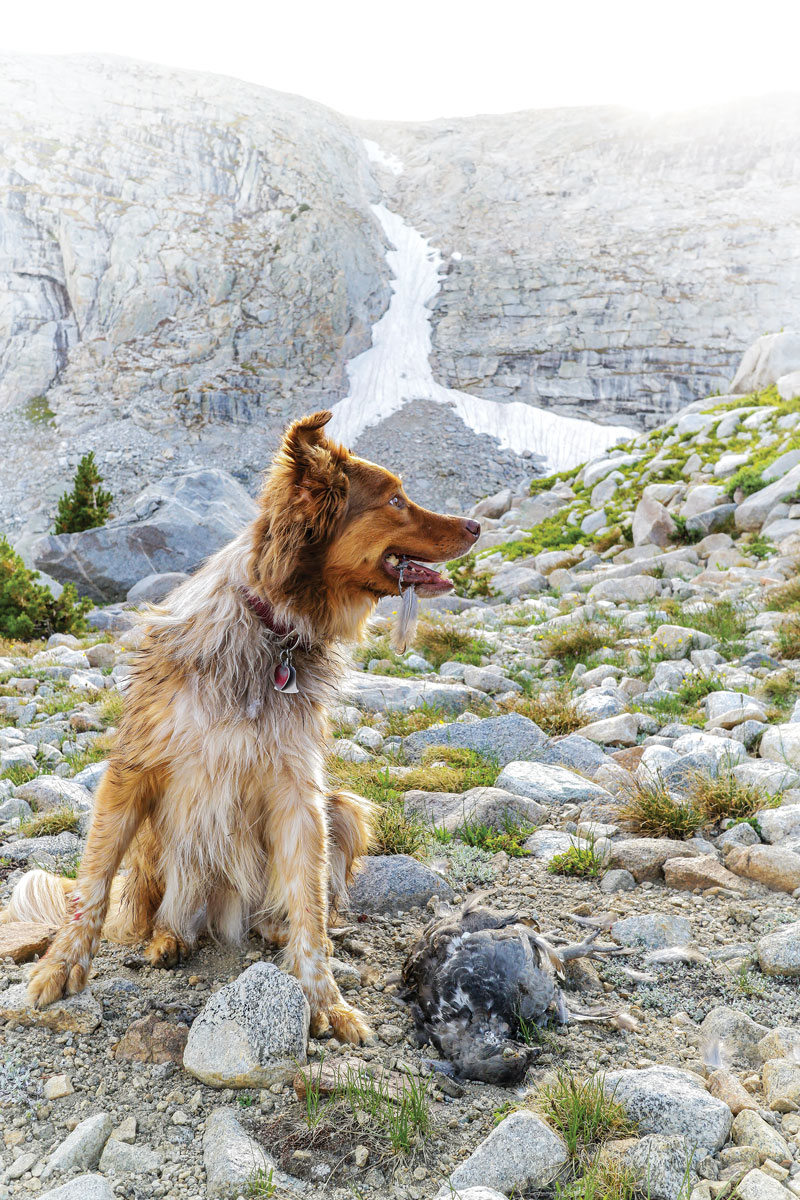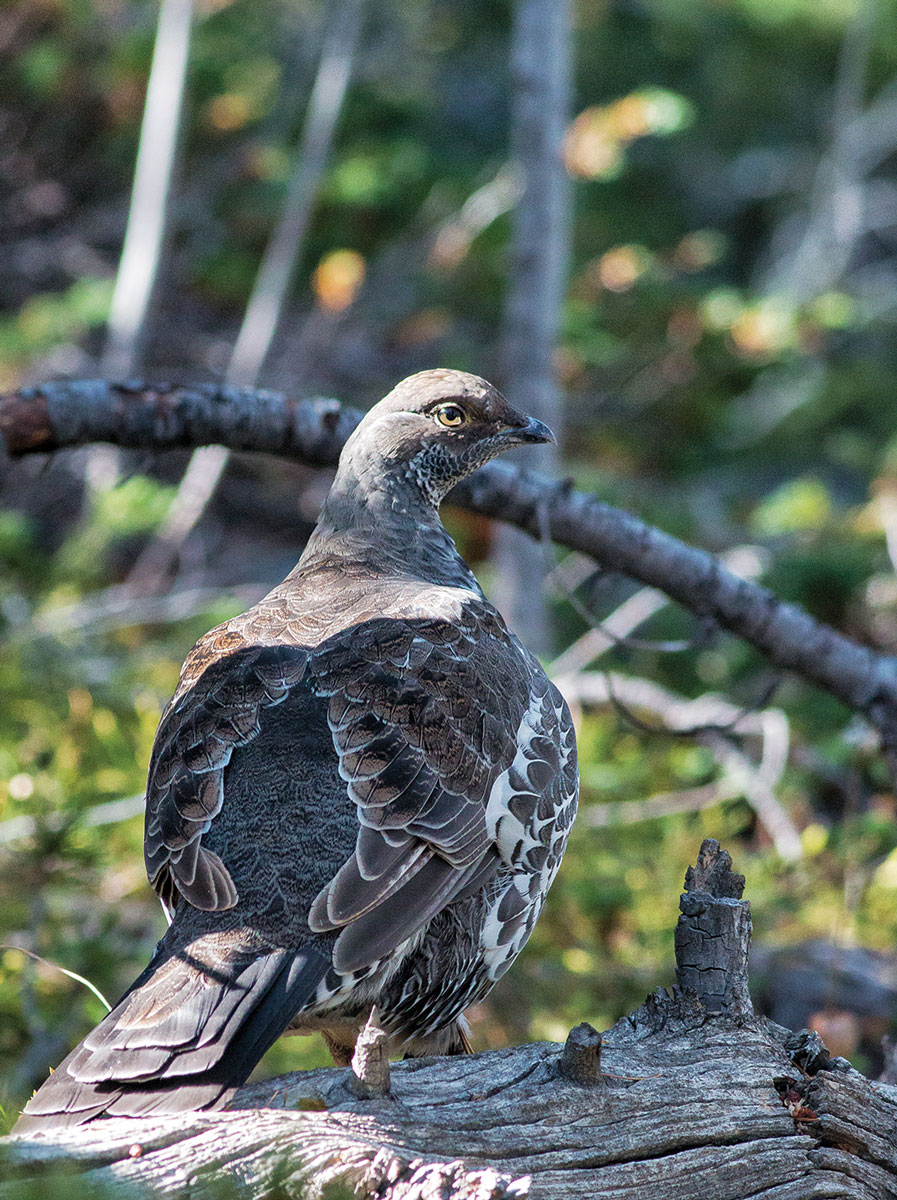
Gaining elevation for grouse & trout
Story & photographs by Garhart Stephenson

September is an interesting month. I spend summers hiking Wyoming’s high country with a fly rod in hand, but come September bird seasons open. Bird hunting ranks as my No. 1 outdoor pursuit, but it always has seemed a shame to abandon the rod just after the high-mountain mosquitos have given up the ghost. I pondered this conundrum with a smile this past September as a feisty brook trout lunged against the invisible tension of my 2-weight fly outfit. What a magnificent little brute: 10 inches of fire-bellied spunk in full spawning hues. As I removed the hook, I thought, Till next time little buddy . . . .
For years I had worked the rugged timberline near this boulder-strewn lake for blue (dusky) grouse, a bird that makes my heart leap with joy, meanwhile harboring a slight tinge of guilt. I had been ignoring my duty to a final fling with the trout before their world became locked under ice for eight months. But this day was different.
Behind me, three plump blue grouse occupied the main compartment of my game bag. Leaning against the bag was a .410 over/under shotgun. My Border collie, Rusty, had done a marvelous job finding the birds, and now he followed me back and forth as I sight-cast to more cruising trout. My newfound satisfaction flourished.
Fall’s first nip promised frosty nights, but a warm afternoon sun allowed my T-shirt. As the sun lowered and the towering peaks began casting long shadows, I knew that if I wanted to make the three-mile hike back to the wilderness boundary without the aid of my headlamp, I should pack up my “surf and turf” dinner and begin the boulder-hopping routine out of the lake crater. I considered cooking part of my day’s take back at the truck but thought it best not to attract any of the black bears that frequent the ridge where I had parked.

Had I brought a small cooking kit on the hike, I could have enjoyed fresh brook trout and grouse by the lake. However, this being my first hike-in cast & blast adventure, I had kept things simple, carrying the bare minimum in my pockets and game bag.
The concept of the cast & blast was nothing new to me, but the hiking aspect was. Traditionally, a cast & blast equates to dividing a single day between hunting and fishing opportunities. One popular option along some Western rivers involves a float trip through good chukar country. In other regions it is more common to occupy a duck blind at first light and then pursue trout after the morning flight once the aquatic insects begin hatching. The possibilities are endless, considering the fact that most gamebirds live near waters that hold gamefish. Of course, the hike-in option is different and requires planning.

With hiking, I find that the “travel light” approach is best, as you will be carrying everything with you once your boots hit dirt. Another consideration is available species, as this will help narrow the equipment choices. In the high country of the West, the bird “menu” typically includes blue, ruffed and/or spruce grouse. There are also places where ptarmigan dwell at very high elevations. All of these generally provide close shooting. For fish, the options are usually brook, golden, rainbow, cutthroat or tiger trout and possibly grayling—all of which require similar tackle.
My gear list for that first foray was fairly simple: a .410 shotgun, ammunition, a slip-on gun sling, a 4-piece 2-weight fly rod, a fly reel, tippet material, a small selection of flies in a tiny hook box, a water bottle & filter, a headlamp, a fleece jacket, sandwiches (in a Ziploc bag that could be reused for the brook trout), a small camera and a pocket knife. The rod was carried in a sleeve across the top of the game belt/bag I wear for bird hunting (it easily would have fit in a vest), and the remaining items ended up in pant pockets and the game bag. Matches, a lighter and a small roll of electrical tape also went in my game bag in case of “emergencies.” Since that first trip I have found little reason to change these items other than to opt for different guns based on whims and add packable raingear when deemed necessary.
The whole arrangement worked rather well. Fishing gear didn’t interfere with mobility during the grouse hunt, and the hunting gear was no problem at the lake. Wearing the gun across my back while fishing proved unnecessary, but it made sense later on streams where leaving gear piled in one spot wasn’t practical.
When planning one of these treks, it is imperative to find a location with both birds and fish in close proximity in order to maximize time spent enjoying both. Making sure that angling and hunting regulations provide overlapping seasons is also a must. Beyond these two aspects and gear choices, I also tend to rely on NOAA’s point-and-click map feature to get forecasts for the locations where I’ll be. Fall weather in the mountains is notoriously fickle and at times dangerous. I stack the odds of a nice day in my favor any time I can.
One noteworthy adventure took place with one of my closest childhood friends, Jim Rotherham. Jim and I had grown up fishing Wyoming’s Wind River Range, but life had taken him to other locations for a number of years. Jim finally had found a way to move back to the country he loved, and because the two of us had not fished for golden trout together since our college days and had not shared a bird hunt for almost a decade, we thought, What better way to get together and enjoy both than a September outing?
When Jim hadn’t showed up at the designated campsite by late the first morning, I figured he had been called into work and reluctantly decided to go it alone. As luck would have it, however, he caught up to me while I was stopped along the road chatting with another bird hunter. He transferred his gear into my Suzuki Samurai, and away we rode, with Rusty across our laps.

The rocky jeep-trail ride was bouncy, even with purposefully deflated 35-inch tires set at low pressure, but it saved us many hours of lost fishing and hunting time. Our hike involved about two miles of easy trail with minimal elevation gain followed by a steep two-mile cross-country trek that took us to 11,000 feet.
I always like to cherry-pick the best stretches of water for my buddies, and when we arrived, the trout were terrifically eager. For the first time in many years I saw my friend truly relax. Jim was once again in his element. After about three hours of superb angling, I reached for the 16-gauge Lefever across my back and removed the sling. Jim assembled his short double, and then we let Rusty guide us with his capable nose.
I feared we might have our work cut out for us, as this wasn’t my best grouse location, but Rusty surprised us and we found a good number of blues—probably the most I’d ever encountered in that spot.
Eventually Jim’s bad knee began to act up. With birds in the bag, nightfall approaching and one of us developing a limp, camp beckoned. We rolled in fairly late but still enjoyed our campfire rituals before turning in. The next day would be tiger trout and ruffed grouse near camp—this time the cast and the blast split up by a short drive.
The tiger trout foray proved much easier on Jim’s knee—the hike being only about 300 yards from the road. If it hadn’t been for the sound of the occasional vehicle, we would have thought that the placid bowl of water among the evergreens was miles from the nearest gravel. We tempted the fish with both spinning and fly tackle but caught only a few. Still, any time someone can hold something as beautiful as a tiger trout is a triumph. In a few weeks the fish would show their spawning hues.
Unfortunately, Jim needed to head down the mountain to prepare for work, leaving me to chase the ruffed grouse solo.


Trekking into the mountains with a shotgun across your back affords you the opportunity to take the “turf” (in this case dusky grouse) for a “surf and turf” dinner.
As with the country we’d worked the previous day for blues, the area around camp was only fair ruffed grouse habitat. I considered driving to a more promising stream a couple miles away where I also could catch brook trout, but then I remembered the grouse I had seen on my summer mountain-bike rides above camp. I had saved hunting these birds for a day such as this. That settled it.
I knew better than to expect a lot of bird contacts. If I could bring just a single grouse to hand, that would be more than enough reward for the day. When I picked up the little 16, Rusty knew it was “go time” and headed up the trail—fervently searching the mixture of evergreens, aspens and sage that followed the tiny trickle of a mountain stream.
Ten minutes into our quest, the thunderous roar of grouse wings shattered the silence. Startled and not completely ready, I received the blessing that only a forest hunter truly can appreciate. A red-phase bird was full on the throttle through an open path between the aspens. I frantically brought up the shotgun as I tried to catch the vanishing grouse in time. I knew that if I blew this opportunity, it could be a long wait before another chance came along. Thank goodness for that Skeet choke in the right barrel. I can’t say if I centered the bird or not, but it was close enough and Rusty enjoyed an easy retrieve.
We continued up the mountain, moving nary a feather until we approached a pair of bogs. There Rusty hit scent, and I followed him quickly. This bird knew what its legs were for, and the chase culminated in a somewhat wild flush—one that I was not able to stop with a shot pattern. Try as we might, we were unable to relocate the grouse.
Upward we ventured, finding several dusting bowls but no occupants. Beyond the rocky outcropping above the springs, the forest was old-growth pine for miles—certainly no place for “King Ruff.” And though a bird in hand is sufficient blessing for any hike, the route back to camp covered additional territory. Much to my delight, we encountered a trio of grouse, one of which actually collided with my shotstring.
I was eternally grateful for another relaxing day with rod and gun, and I strolled back leisurely, viewing my magnificent surroundings in the now-slanting light. Golden aspen leaves stirred by the evening breeze flickered like so many sequins. The sweet aroma of autumn filled my nostrils, and somewhere in the distance a Clark’s nutcracker cried out. The grouse remained in my hand during the hike back to the camper—a treasure to be admired.
High-country cast & blast adventures have opened up many possibilities and even solved the inner conflict I had when another friend wanted to catch his first golden trout but couldn’t go until late September. My bird hunter’s conscience nagged me about skipping a day with gun and dog until I remembered the golden trout-blue grouse combo. As a result, Ben Linnell caught his first golden trout in the same stream where Jim and I had ventured. Once Ben had those tricky fish figured out, I left him to work the stream to his heart’s content as I followed Rusty toward timberline with my shotgun. Our final bird flushed from the last tree that could have been considered a tree on that mountain. No higher refuge was available.
This bird offered an amazing flight path, sweeping swiftly past my right shoulder and forcing me to perform a quick about face while mounting the gun. At that point the bird hurtled down the mountain, paralleling a high granite wall. I was grateful for the wall and the rubble below it, for no trees grow out of such rock piles. At the Lefever’s report, a plume of feathers drifted slowly to earth on the cool mountain breeze. The weight of a third grouse in the bag on the hike down to Ben felt just right.
There are few things more satisfying than carrying a rod and gun afield—taking advantage of every opportunity for a most fulfilling day. Thankfully, there are many places in the US where cast & blast outings are possible. All that is required is gamebirds, fish and the desire to make the most of your time outdoors. 




